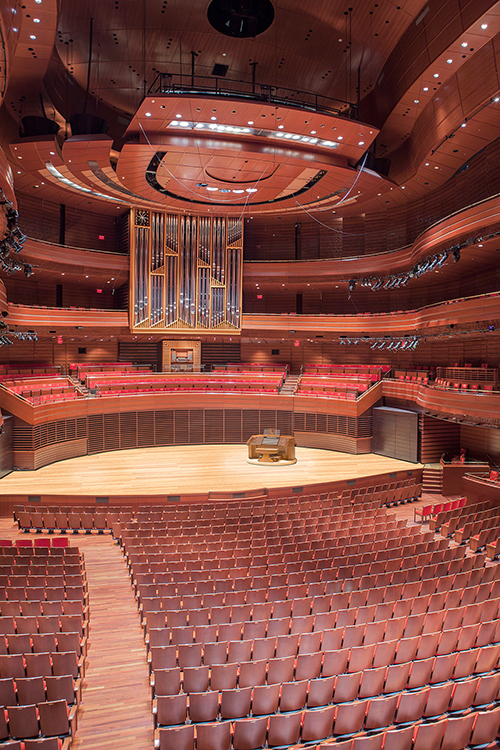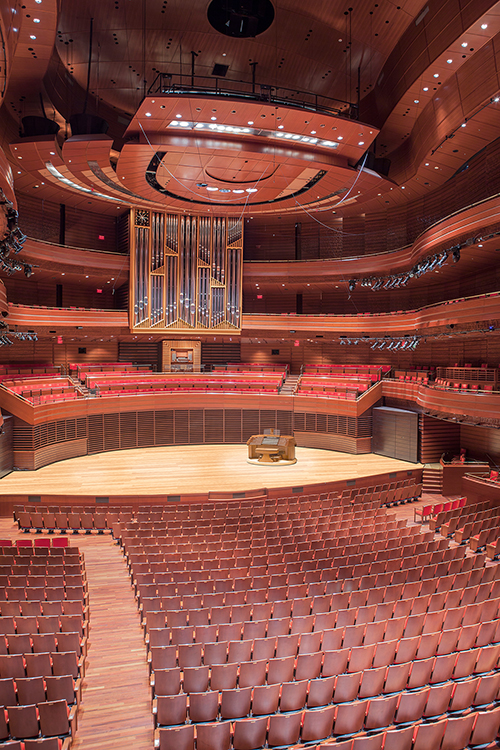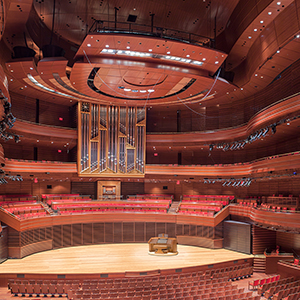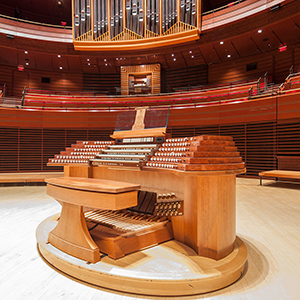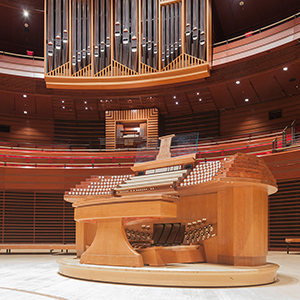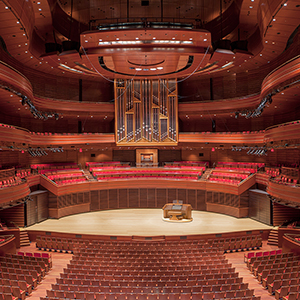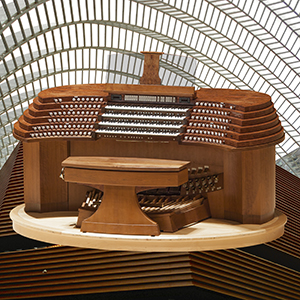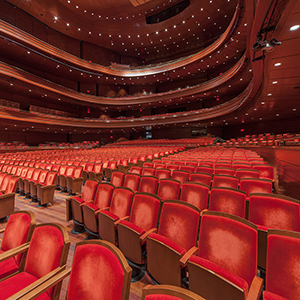The NEO Press - Kimmel Center
About the Kimmel Center Organ
Verizon Hall, in Philadelphia’s Kimmel Center for the Performing Arts, is the new home of Dobson Op. 76, America’s largest mechanical action concert hall organ. Also home to the world-renowned Philadelphia Orchestra, the Kimmel Center was designed by New York architect Rafael Viñoly. The acoustical design is the work of Russell Johnson of Artec Consultants, Inc., also of New York. To accommodate differing events and ensembles of various sizes, Verizon Hall’s acoustics can be adjusted by the use of a movable canopy, drapes and reverberation chambers. Verizon Hall seats 2,500 people.
The new organ has four keyboards for the hands, called manuals, and one keyboard for the feet, called the pedalboard. These five keyboards control five major groups of pipes, or divisions. The entire instrument is placed above and to the rear of the stage. The new organ contains 6,938 pipes, which are constructed of wood or metal depending on the type of tone desired. The largest pipes are made of wood and are about two feet square and 32 feet tall. The smallest pipes are the size of a slender drinking straw. Several of the larger metal pipes are placed in the organ’s case to form a visual display, or façade. They are made from an alloy of highly polished tin. These pipes are arranged in a broadly curving arc, and lean outward at a four-degree angle, thereby coinciding with the architecture of the Hall’s balconies. This is the first instrument ever constructed with pipes of this size mounted in this manner.
The organ’s main console is located below the façade and operates the organ mechanically. This mechanical action or tracker system remains unchanged in principle from organs built centuries ago and is preferred by discerning musicians worldwide. A second, movable console that plays the organ electrically is also provided for use on the stage. It is connected to the organ proper by a computerized electronic system, which condenses the signals from the keyboards and other controls down to only six wires. A complementary system near the pipes reconstitutes this six-wire signal and electrically operates the valves under the pipes as the organist plays.
Four blowers totaling 27 horsepower supply the organ with air ranging in pressure from 4" to 23" water column. These blowers are placed in the basement for sound isolation reasons, and the pressurized air is carried to the organ through large insulated ducts. The total weight of the organ and its structure is approximately 32 tons.
The facade, casework and largest 32' pipes were installed during Phase 1 in the fall of 2001, so that the appearance of Verizon Hall was complete for its opening on 16 December 2001. Because the Hall is in use during the season, installation of the rest of the organ took place in Phase 2 during the summers of 2004 and 2005. Tonal finishing began in October 2005, with the voicers working through the night so that the regular events of the Hall were not disrupted.
Stoplist development and the scaling of the pipes was a collaboration between the Dobson firm and Los Angeles organ builder Manuel J. Rosales. Construction of the organ and all voicing and tonal finishing has been the responsibility of Dobson.
The new organ has four keyboards for the hands, called manuals, and one keyboard for the feet, called the pedalboard. These five keyboards control five major groups of pipes, or divisions. The entire instrument is placed above and to the rear of the stage. The new organ contains 6,938 pipes, which are constructed of wood or metal depending on the type of tone desired. The largest pipes are made of wood and are about two feet square and 32 feet tall. The smallest pipes are the size of a slender drinking straw. Several of the larger metal pipes are placed in the organ’s case to form a visual display, or façade. They are made from an alloy of highly polished tin. These pipes are arranged in a broadly curving arc, and lean outward at a four-degree angle, thereby coinciding with the architecture of the Hall’s balconies. This is the first instrument ever constructed with pipes of this size mounted in this manner.
The organ’s main console is located below the façade and operates the organ mechanically. This mechanical action or tracker system remains unchanged in principle from organs built centuries ago and is preferred by discerning musicians worldwide. A second, movable console that plays the organ electrically is also provided for use on the stage. It is connected to the organ proper by a computerized electronic system, which condenses the signals from the keyboards and other controls down to only six wires. A complementary system near the pipes reconstitutes this six-wire signal and electrically operates the valves under the pipes as the organist plays.
Four blowers totaling 27 horsepower supply the organ with air ranging in pressure from 4" to 23" water column. These blowers are placed in the basement for sound isolation reasons, and the pressurized air is carried to the organ through large insulated ducts. The total weight of the organ and its structure is approximately 32 tons.
The facade, casework and largest 32' pipes were installed during Phase 1 in the fall of 2001, so that the appearance of Verizon Hall was complete for its opening on 16 December 2001. Because the Hall is in use during the season, installation of the rest of the organ took place in Phase 2 during the summers of 2004 and 2005. Tonal finishing began in October 2005, with the voicers working through the night so that the regular events of the Hall were not disrupted.
Stoplist development and the scaling of the pipes was a collaboration between the Dobson firm and Los Angeles organ builder Manuel J. Rosales. Construction of the organ and all voicing and tonal finishing has been the responsibility of Dobson.
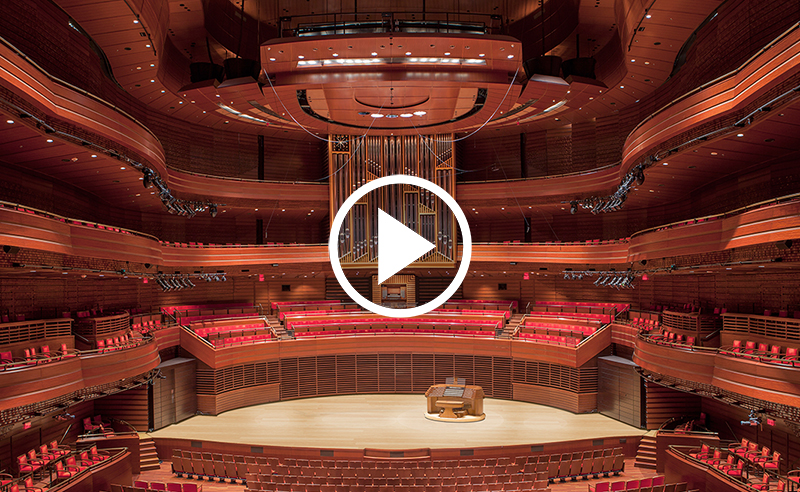
The Chamber Orchestra of Philadelphia
Paulus Organ Concerto: Finale
Paulus Organ Concerto: Finale
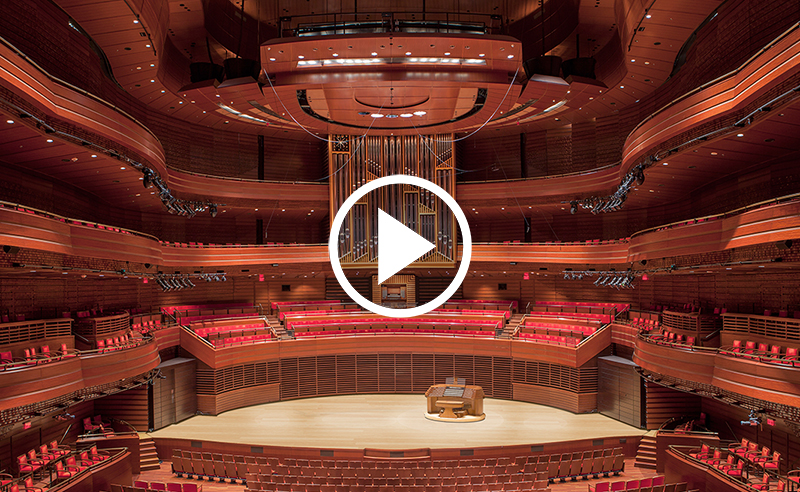
Monica Czausz performs Messiaen
L'Ascension: III Transports de joie
L'Ascension: III Transports de joie

